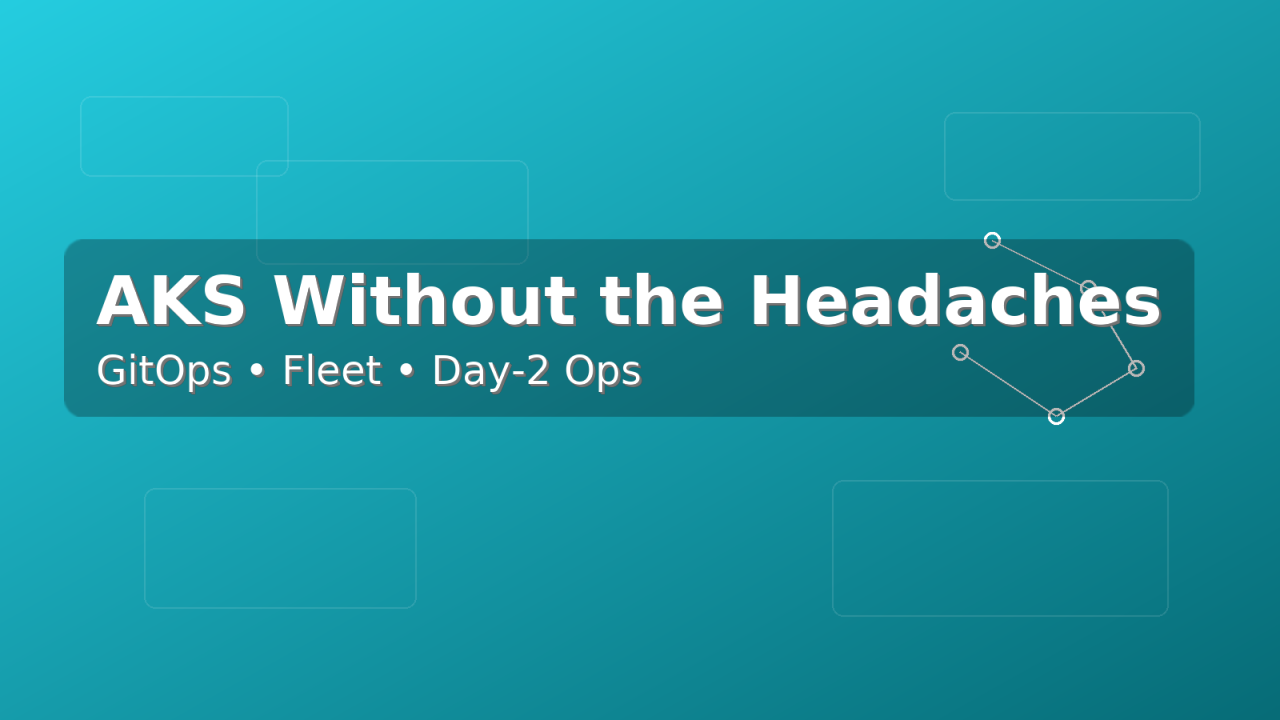64
Goal: Production-grade AKS lifecycle using GitOps and multi-cluster management, with pragmatic day-2 operations.
Architecture
GitHub or Azure Repos
main env/dev env/prod
| | |
| PR->merge gates |
v v v
┌──────────────────────────────────┐
│ Flux │
│ GitRepository + Kustomization │
│ Reconcile loop per cluster │
└──────────────────────────────────┘
^ ^ ^
| | |
┌────────────┴───┐ ┌─┴─────────────┐ ┌───────────────┐
│ Cluster Dev │ │ Cluster QA │ │ Cluster Prod │
│ MI + OIDC │ │ MI + OIDC │ │ MI + OIDC │
│ CNI + NP │ │ CNI + NP │ │ CNI + NP │
└──────┬─────────┘ └─────┬─────────┘ └──────┬────────┘
| | |
flux bootstrap flux bootstrap flux bootstrap
| | |
bootstrap repo path bootstrap repo path bootstrap repo path
clusters/dev clusters/qa clusters/prod Notes: OIDC issuer and Workload Identity connect pods to Azure resources. CNI is Azure CNI or Cilium. NP means NetworkPolicy.
Cluster IaC
az CLI quickstart
# Resource group and ACR
az group create -n rg-aks-prod -l uksouth
az acr create -n acrprod123 -g rg-aks-prod --sku Premium
# AKS with managed identity, OIDC, workload identity, autoscaler
az aks create \
-g rg-aks-prod -n aks-prod \
--enable-managed-identity \
--enable-oidc-issuer --enable-workload-identity \
--network-plugin azure \
--node-count 3 --min-count 3 --max-count 10 \
--enable-cluster-autoscaler \
--auto-upgrade-channel stable
# Attach ACR pull
az aks update -g rg-aks-prod -n aks-prod --attach-acr acrprod123
# Add a user node pool for workloads
az aks nodepool add -g rg-aks-prod --cluster-name aks-prod \
-n userpool --mode User --node-count 3 \
--enable-cluster-autoscaler --min-count 3 --max-count 20
# Flux bootstrap against repo
az aks get-credentials -g rg-aks-prod -n aks-prod
flux bootstrap github \
--owner your-org --repository aks-gitops \
--branch env/prod --path clusters/prod --personal Bicep sketch
param location string = resourceGroup().location
param clusterName string = 'aks-prod'
param acrId string
resource aks 'Microsoft.ContainerService/managedClusters@2024-05-01' = {
name: clusterName
location: location
identity: { type: 'SystemAssigned' }
properties: {
dnsPrefix: '${clusterName}-dns'
oidcIssuerProfile: { enabled: true }
workloadIdentityProfile: { enabled: true }
kubernetesVersion: '1.29.7' // pin intentionally
apiServerAccessProfile: {
enablePrivateCluster: true
}
autoScalerProfile: {
maxEmptyBulkDelete: '10'
scanInterval: '20s'
}
agentPoolProfiles: [
{
name: 'system'
mode: 'System'
count: 3
vmSize: 'Standard_D4s_v5'
osType: 'Linux'
enableAutoScaling: true
minCount: 3
maxCount: 10
orchestratorVersion: '1.29.7'
}
]
networkProfile: {
networkPlugin: 'azure' // or 'none' with Cilium CNI addon
}
}
}
@description('User pool defined as child resource for surge and taints')
resource userpool 'Microsoft.ContainerService/managedClusters/agentPools@2024-05-01' = {
name: '${aks.name}/userpool'
properties: {
mode: 'User'
count: 3
vmSize: 'Standard_D4s_v5'
enableAutoScaling: true
minCount: 3
maxCount: 20
nodeTaints: [ 'workload=true:NoSchedule' ]
}
}
// ACR pull permission
resource acrRole 'Microsoft.Authorization/roleAssignments@2022-04-01' = {
name: guid(aks.id, 'AcrPull')
scope: resourceId('Microsoft.ContainerRegistry/registries', split(acrId,'/')[8])
properties: {
roleDefinitionId: subscriptionResourceId('Microsoft.Authorization/roleDefinitions', '7f951dda-4ed3-4680-a7ca-43fe172d538d')
principalId: aks.identity.principalId
principalType: 'ServicePrincipal'
}
} Workload Identity for a pod
apiVersion: v1
kind: ServiceAccount
metadata:
name: sa-blob
namespace: app
annotations:
azure.workload.identity/client-id: <user-assigned-mi-client-id>
azure.workload.identity/tenant-id: <tenant-id>
---
apiVersion: apps/v1
kind: Deployment
metadata:
name: api
namespace: app
spec:
replicas: 3
selector: { matchLabels: { app: api } }
template:
metadata: { labels: { app: api } }
spec:
serviceAccountName: sa-blob
containers:
- name: api
image: acrprod123.azurecr.io/api:1.2.3
env:
- name: AZURE_CLIENT_ID
valueFrom:
fieldRef: { fieldPath: metadata.annotations['azure.workload.identity/client-id'] } GitOps with Flux
Environment branches hold overlays. Flux reconciles per cluster.
apiVersion: source.toolkit.fluxcd.io/v1
kind: GitRepository
metadata:
name: gitops
namespace: flux-system
spec:
interval: 1m
url: https://github.com/your-org/aks-gitops
ref: { branch: env/prod }
---
apiVersion: kustomize.toolkit.fluxcd.io/v1
kind: Kustomization
metadata:
name: platform
namespace: flux-system
spec:
interval: 1m
prune: true
sourceRef: { kind: GitRepository, name: gitops }
path: ./platform
wait: true
dependsOn: []
---
apiVersion: kustomize.toolkit.fluxcd.io/v1
kind: Kustomization
metadata:
name: workloads
namespace: flux-system
spec:
interval: 1m
prune: true
sourceRef: { kind: GitRepository, name: gitops }
path: ./workloads/prod
dependsOn:
- name: platform Repo structure example:
/cluster-bootstrap
/clusters/dev
/clusters/prod
/platform/cert-manager
/platform/ingress
/workloads/dev
/workloads/prod Fleet and multi cluster patterns
- Namespaces vs clusters: use namespaces for teams with shared trust and soft isolation. Use dedicated clusters for tenant isolation, regulatory boundaries, or conflicting add-ons.
- Placement: one repo, many clusters. Parameterize overlays by cluster labels. Flux supports kustomize substitutions and Json6902 patches.
- Multi tenancy: restrict RBAC to namespaces. Use network policies as a default deny.
NetworkPolicy baseline:
apiVersion: networking.k8s.io/v1
kind: NetworkPolicy
metadata:
name: default-deny
namespace: app
spec:
podSelector: {}
policyTypes: [Ingress, Egress]
---
apiVersion: networking.k8s.io/v1
kind: NetworkPolicy
metadata:
name: allow-dns-and-egress-gw
namespace: app
spec:
podSelector: {}
egress:
- to:
- namespaceSelector: { matchLabels: { kube-system: "true" } }
ports: [ { port: 53, protocol: UDP }, { port: 53, protocol: TCP } ]
- to:
- ipBlock: { cidr: 0.0.0.0/0 } # replace with egress IP or firewall
ports: [ { port: 443, protocol: TCP } ]
policyTypes: [Egress] Day 2 operations
- Upgrades: pin minor in Bicep. Rotate node images regularly.
# Control plane first
az aks upgrade -g rg-aks-prod -n aks-prod --control-plane-only --kubernetes-version 1.29.7
# Node images
az aks upgrade -g rg-aks-prod -n aks-prod --node-image-only
# Optional pool level
az aks nodepool upgrade -g rg-aks-prod --cluster-name aks-prod -n userpool - Blue or green strategy: create a parallel user pool with taints and drain workloads by label. At the traffic layer, use Gateway API with weighted backends.
apiVersion: gateway.networking.k8s.io/v1
kind: HTTPRoute
metadata:
name: shop
spec:
parentRefs: [ { name: public-gw } ]
rules:
- backendRefs:
- name: shop-blue
weight: 90
- name: shop-green
weight: 10 - Backup and restore: Velero is portable. Snapshot volumes via CSI. For Azure native, use Azure Backup for AKS to protect PVs and workloads.
- Egress and Private Link: use a NAT Gateway or Azure Firewall for deterministic egress IPs. Prefer Private Link to ACR, Key Vault, Storage. Lock down API server with private cluster and authorized subnets.
Observability
- Container Insights: enable via addon for node and control plane metrics and logs. Route to Log Analytics.
az aks enable-addons -g rg-aks-prod -n aks-prod -a monitoring - Prometheus stack: kube-prometheus-stack via Flux. Record SLOs and alert on burn rates.
apiVersion: monitoring.coreos.com/v1
kind: PrometheusRule
metadata:
name: slo-api
namespace: monitoring
spec:
groups:
- name: api-latency
rules:
- record: slo:request_latency_seconds:rate5m
expr: histogram_quantile(0.95, sum by (le) (rate(http_request_duration_seconds_bucket{job="api"}[5m])))
- alert: APIHighErrorRate
expr: sum(rate(http_requests_total{job="api",code=~"5.."}[5m])) / sum(rate(http_requests_total{job="api"}[5m])) > 0.05
for: 10m
labels: { severity: page }
annotations:
summary: API error rate above 5 percent Dashboards: surface SLO target, error budget remaining, and burn alerts. Grafana, Azure Managed Grafana, or vendor of choice are fine.
Security
- Secrets: use Secrets Store CSI with Azure provider. Mount secrets from Key Vault with Workload Identity.
apiVersion: secrets-store.csi.x-k8s.io/v1
kind: SecretProviderClass
metadata:
name: kv-secrets
namespace: app
spec:
provider: azure
parameters:
useWorkloadIdentity: "true"
clientID: <user-assigned-mi-client-id>
keyvaultName: my-kv
objects: |
array:
- |
objectName: app-secret
objectType: secret
tenantId: <tenant-id> - Image provenance: sign images in CI using Cosign. Store in ACR with OCI attestations. Enforce at admission.
- Policy: Gatekeeper or Kyverno. Example Kyverno verifyImages.
apiVersion: kyverno.io/v1
kind: ClusterPolicy
metadata:
name: verify-signed-images
spec:
rules:
- name: require-cosign
match:
any:
- resources:
kinds: [Pod, Deployment]
verifyImages:
- image: "acrprod123.azurecr.io/*"
keyless:
issuer: "https://token.actions.githubusercontent.com"
subject: "repo:your-org/*:ref:refs/heads/main"
attestations:
- predicateType: "cosign.sigstore.dev/attestation/v1" Gatekeeper example for required labels:
apiVersion: constraints.gatekeeper.sh/v1beta1
kind: K8sRequiredLabels
metadata:
name: req-team-label
spec:
match:
kinds:
- apiGroups: [""]
kinds: ["Namespace"]
parameters:
labels: ["owner", "costCenter"] Ops checklist
- Pull requests gate changes. Flux reconciles in minutes.
- Autoscaler and max surge tuned. Drains scripted during upgrades.
- Egress pinned to NAT IPs. Private Link for supply chain.
- SLOs define your paging. Policy prevents bad images and missing labels.
- Backups verified monthly. Restore playbook tested.

